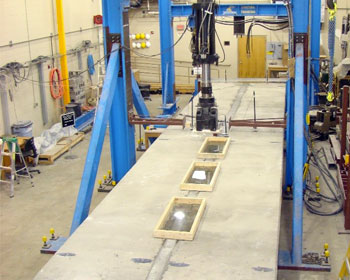MPC Research Reports
Report Details
Abstract
 Precast/prestressed double tee bridge girders are widely used for accelerated bridge construction on local roads in South Dakota. A common issue among existing double tee bridges in South Dakota is the rapid deterioration of longitudinal joints (shear keyways) between adjacent girders. Deteriorated joints allow moisture and deicing chemicals to reach the deck reinforcement, leading to premature corrosion of reinforcing steel and spalling of concrete. The structural performance of conventional and proposed longitudinal joints between precast double tee bridge girders was examined experimentally under cyclic and monotonic loading. Two 40-ft. long full-scale bridge superstructure specimens, each consisting of two joined double tee girders, were tested at the Lohr Structures Laboratory at South Dakota State University (SDSU). Each specimen represented two adjacent interior girders of a two-lane bridge having a width of an approximately 31 feet. The proposed continuous joint with overlapping steel mesh reinforcement in a grouted shear keyway exhibited substantially improved serviceability and strength performance characteristics over the conventional grouted joint with discrete welded connections.
Precast/prestressed double tee bridge girders are widely used for accelerated bridge construction on local roads in South Dakota. A common issue among existing double tee bridges in South Dakota is the rapid deterioration of longitudinal joints (shear keyways) between adjacent girders. Deteriorated joints allow moisture and deicing chemicals to reach the deck reinforcement, leading to premature corrosion of reinforcing steel and spalling of concrete. The structural performance of conventional and proposed longitudinal joints between precast double tee bridge girders was examined experimentally under cyclic and monotonic loading. Two 40-ft. long full-scale bridge superstructure specimens, each consisting of two joined double tee girders, were tested at the Lohr Structures Laboratory at South Dakota State University (SDSU). Each specimen represented two adjacent interior girders of a two-lane bridge having a width of an approximately 31 feet. The proposed continuous joint with overlapping steel mesh reinforcement in a grouted shear keyway exhibited substantially improved serviceability and strength performance characteristics over the conventional grouted joint with discrete welded connections.
How to Cite
Wehbe, Nadim I., and Michael Konrad. Precast Bridge Girder Details for Improved Performance, MPC-17-340. North Dakota State University - Upper Great Plains Transportation Institute, Fargo: Mountain-Plains Consortium, 2017.

